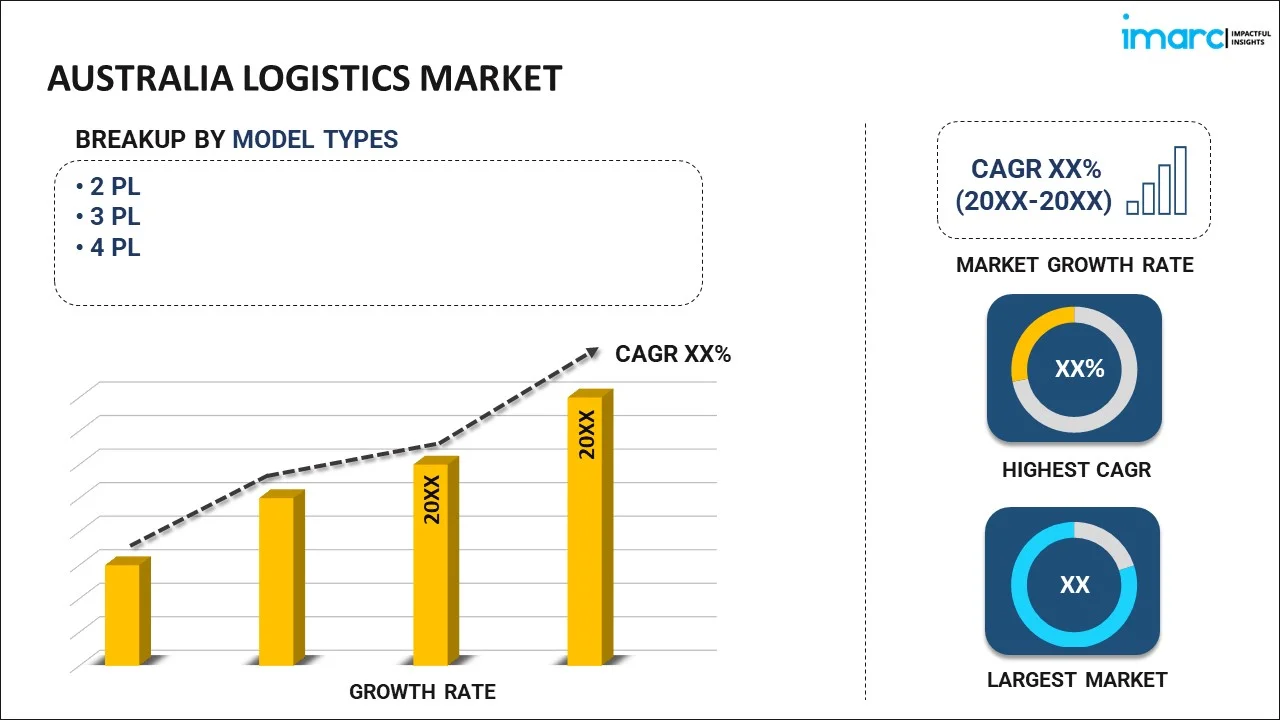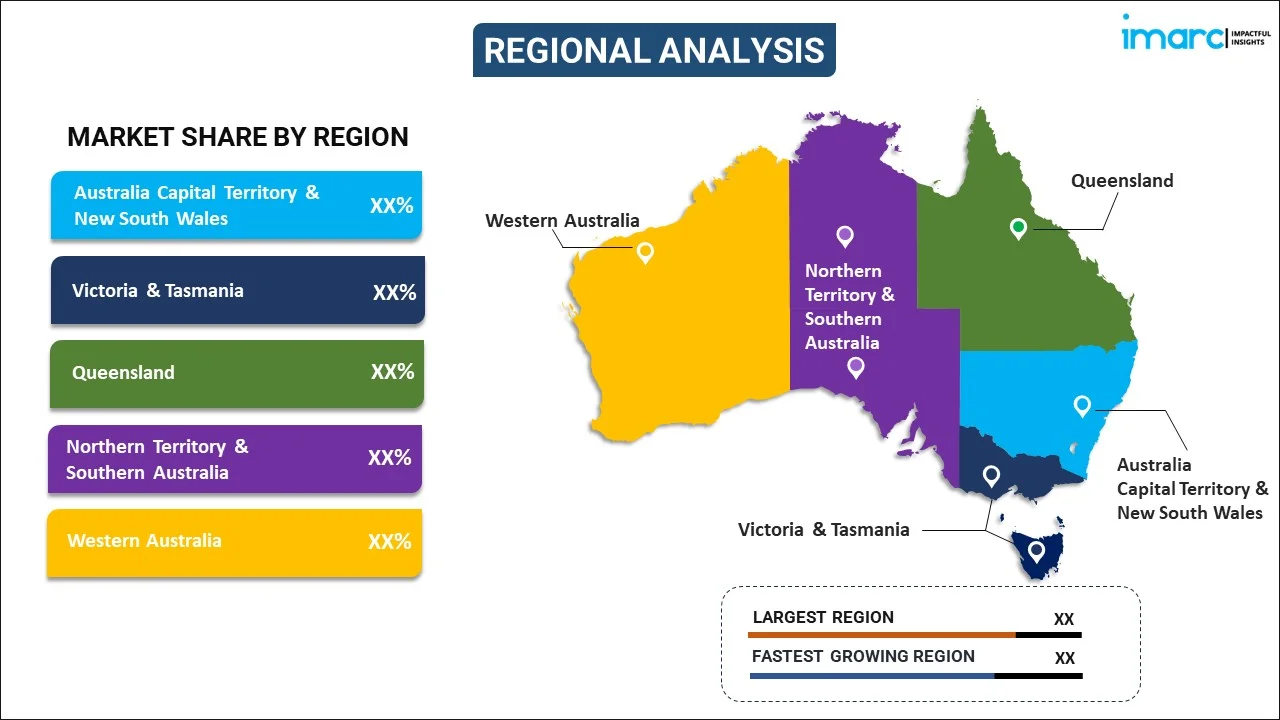
Australia Logistics Market Report by Model Type (2 PL, 3 PL, 4 PL), Transportation Mode (Roadways, Seaways, Railways, Airways), End Use (Manufacturing, Consumer Goods, Retail, Food and Beverages, IT Hardware, Healthcare, Chemicals, Construction, Automotive, Telecom, Oil and Gas, and Others), and Region 2025-2033
Australia Logistics Market Size:
Australia logistics market size is projected to exhibit a growth rate (CAGR) of 3.42% during 2025-2033. The increasing need for the execution of various interconnected activities and strategic coordination to facilitate the timely delivery of goods and services and continuous improvements in supply chain management are primarily augmenting the market growth across the country.
|
Report Attribute
|
Key Statistics
|
|---|---|
|
Base Year
|
2024 |
|
Forecast Years
|
2025-2033 |
|
Historical Years
|
2019-2024
|
| Market Growth Rate (2025-2033) | 3.42% |
Australia Logistics Market Analysis:
- Major Market Drivers: The increasing international trade ties across the country and its strategic geographical location are primarily stimulating the demand for efficient logistics services in Australia. Additionally, companies in the country are introducing novel inventory management systems, which is acting as another significant growth-inducing factor.
- Key Market Trends: The development of technological advancements is playing a crucial role in augmenting the market growth in Australia. Besides this, the rising integration of advanced technologies, including automation, real-time tracking systems, artificial intelligence, etc., to provide a competitive edge to logistics providers is further catalyzing the Australia logistics market.
- Challenges and Opportunities: The logistics market in Australia faces numerous challenges that can impact cost efficiency, efficiency, and sustainability. Primarily, the extensive distances between remote areas and major cities are leading to higher transportation costs and longer delivery miles, which can hinder the market growth across the country. Also, the growing consumer expectations for faster, more transparent, and cheaper delivery solutions pose a serious challenge for logistics providers. Meeting these expectations requires numerous investments in logistics infrastructures and technology. However, the rising focus on strategic planning, skilled workforce development, and several technological advancements will continue to propel the market growth across the country.
Australia Logistics Market Trends:
The Growing E-Commerce Industry
The increasing number of e-commerce activities is positively influencing how goods are stored, delivered, and handled. Australia is the 12th largest market for the e-commerce industry, with a predicted revenue of US$ 53,066.5 Million by 2024, placing it ahead of Italy. It is anticipated to bolster by 10.3% in 2024. As consumers in Australia are inclining towards online platforms, leading logistics companies are innovating to meet the evolving demands of customers in the e-commerce industry. This, in turn, is leading to the development of more novel supply chains. As reported by Australia Post, more individuals across the county are shopping online, with four-in-five households, 81% buying something online at some point during the year. In addition, shoppers spent US$ 62.3 Billion on online physical goods. Such high grossing in online sales indicates the country's rising interest in e-commerce activities, which will continue to augment the market growth.
The Rising Focus on Sustainability
The increasing focus among businesses and individuals on sustainability is positively influencing logistics operations in Australia. Consequently, they are widely utilizing electric vehicles for deliveries, optimizing routes to minimize carbon dioxide emissions, implementing sustainable packaging solutions, etc., which is bolstering the market growth. For example, DHL Freight developed the Go Green Plus service to minimize CO2 emissions from road transport vehicles. This was achieved via carbon in setting, which is a reduction in emissions of carbon dioxide and other greenhouse gases through extensive investments in green road transportation technologies and fuels. In addition, The Port of Brisbane is the largest seaport in the state of Queensland. It is the third fastest and busiest-growing port in all of Australia. This port is responsible for more than 28 million cargo each year and 2600 ships and is ranked at the Maritime Security Level 1. Consequently, stringent regulations in Brisbane are expected to augment the market growth in the coming years.
The Growing Improvements in Supply Chain Management
Australian logistics companies are extensively focusing on investing in enhanced inventory management solutions and exploring reshoring or nearshoring options to ensure supply chain continuity and mitigate risk factors. For instance, Amazon announced the construction of its first sort center facility in the country commenced in Melbourne. The 15,600 sqm operations facility was developed at Goodman Group's new Amaroo Business Park in Craigieburn. The purpose-built sort center located in the north of Melbourne was introduced to enhance the company's delivery speed for customers across the country. In addition to this, an online retailer named MyDeal launched a new global activities marketplace called Amazed.com in Australia. The new website was developed to utilize MyDeal's proprietary marketplace technology and the existing 1 million active customer base, which, in turn, offered a one-stop shopping experience for locals.
The Launch of Regulatory Policies and Infrastructure Developments
Government bodies in Australia are launching numerous favorable policies that are acting as significant growth-inducing factors. They are implementing regulations, including safety standards, trade agreements, environmental guidelines, etc., which are propelling the Australia logistics market. For example, regulation authorities implemented the Heavy Vehicle National Law (HVNL) regarding the usage of heavy vehicles that have a gross vehicle mass of more than 4.5 tons. It applies nationally, except for Western Australia and the Northern Territory. Moreover, these bodies are also significantly investing in infrastructure projects, including rail network expansions and port upgrades, to improve logistics connectivity and efficiency. They introduced a robust 10-year infrastructure pipeline valued at US $120 Billion, specifically focusing on delivering land transport projects that hold national significance and contribute to shaping the nation's future. The 2023-24 budget represented their initiatives to invest in infrastructure development pipelines that are integral to nation-building endeavors. These policies are crucial for constructing sustainable projects, selected based on diverse economic and societal goals, encompassing quality of life enhancement, regional connectivity, and safety enhancement.
Australia Logistics Market Segmentation:
IMARC Group provides an analysis of the key trends in each segment of the market, along with forecasts at the country level for 2025-2033. Our report has categorized the market based on model type, transportation mode, and end use.
Breakup by Model Type:

- 2 PL
- 3 PL
- 4 PL
The report has provided a detailed breakup and analysis of the market based on the model type. This includes 2 PL, 3 PL, and 4 PL.
Breakup by Transportation Mode:
- Roadways
- Seaways
- Railways
- Airways
A detailed breakup and analysis of the market based on the transportation mode have also been provided in the report. This includes roadways, seaways, railways, and airways.
Breakup by End Use:
- Manufacturing
- Consumer Goods
- Retail
- Food and Beverages
- IT Hardware
- Healthcare
- Chemicals
- Construction
- Automotive
- Telecom
- Oil and Gas
- Others
The report has provided a detailed breakup and analysis of the market based on the end use. This includes manufacturing, consumer goods, retail, food and beverages, IT hardware, healthcare, chemicals, construction, automotive, telecom, oil and gas, and others.
Breakup by Region:

- Australia Capital Territory & New South Wales
- Victoria & Tasmania
- Queensland
- Northern Territory & Southern Australia
- Western Australia
The report has also provided a comprehensive analysis of all the major Australia markets, which include Australia Capital Territory & New South Wales, Victoria & Tasmania, Queensland, Northern Territory & Southern Australia, and Western Australia.
Competitive Landscape:
- The market research report has also provided a comprehensive analysis of the competitive landscape in the market. Competitive analysis such as market structure, key player positioning, top winning strategies, competitive dashboard, and company evaluation quadrant has been covered in the report. Also, detailed profiles of all major companies have been provided.
Australia Logistics Market News:
- February 2024: The Federal Government has approved efforts to increase the activities that can be undertaken at Port of Broome, Western Australia, including working with border agencies to secure expanded First Point of Entry (FPOE) status for the port.
- February 2024: The Australian Rail Track Corporation (ARTC) organized a ribbon-cutting ceremony to mark the completion of works to duplicate the Botany Rail line and developed a new Cabramatta Loop after 2.5 years of construction.
- March 2024: The Brisbane Airport Corporation (BAC) has stated that construction has begun on a new state-of-the-art, parcel facility for Australia Post, the largest industrial facility undertaken by the airport to date. BAC is managing the delivery and design of Australia Post’s StarTrack Premium site, making it the postal service’s second largest in Queensland.
Australia Logistics Market Report Scope:
| Report Features | Details |
|---|---|
| Base Year of the Analysis | 2024 |
| Historical Period | 2019-2024 |
| Forecast Period | 2025-2033 |
| Units | Million USD |
| Scope of the Report | Exploration of Historical Trends and Market Outlook, Industry Catalysts and Challenges, Segment-Wise Historical and Future Market Assessment:
|
| Model Types Covered | 2 PL, 3 PL, 4 PL |
| Transportation Modes Covered | Roadways, Seaways, Railways, Airways |
| End Uses Covered | Manufacturing, Consumer Goods, Retail, Food and Beverages, IT Hardware, Healthcare, Chemicals, Construction, Automotive, Telecom, Oil and Gas, Others |
| Regions Covered | Australia Capital Territory & New South Wales, Victoria & Tasmania, Queensland, Northern Territory & Southern Australia, Western Australia |
| Customization Scope | 10% Free Customization |
| Post-Sale Analyst Support | 10-12 Weeks |
| Delivery Format | PDF and Excel through Email (We can also provide the editable version of the report in PPT/Word format on special request) |
Key Questions Answered in This Report:
- How has the Australia logistics market performed so far and how will it perform in the coming years?
- What has been the impact of COVID-19 on the Australia logistics market?
- What is the breakup of the Australia logistics market on the basis of model type?
- What is the breakup of the Australia logistics market on the basis of transportation mode?
- What is the breakup of the Australia logistics market on the basis of end use?
- What are the various stages in the value chain of the Australia logistics market?
- What are the key driving factors and challenges in the Australia logistics?
- What is the structure of the Australia logistics market and who are the key players?
- What is the degree of competition in the Australia logistics market?
Key Benefits for Stakeholders:
- IMARC’s industry report offers a comprehensive quantitative analysis of various market segments, historical and current market trends, market forecasts, and dynamics of the Australia logistics market from 2019-2033.
- The research report provides the latest information on the market drivers, challenges, and opportunities in the Australia logistics market.
- Porter's five forces analysis assists stakeholders in assessing the impact of new entrants, competitive rivalry, supplier power, buyer power, and the threat of substitution. It helps stakeholders to analyze the level of competition within the Australia logistics industry and its attractiveness.
- The competitive landscape allows stakeholders to understand their competitive environment and provides an insight into the current positions of key players in the market.
Need more help?
- Speak to our experienced analysts for insights on the current market scenarios.
- Include additional segments and countries to customize the report as per your requirement.
- Gain an unparalleled competitive advantage in your domain by understanding how to utilize the report and positively impacting your operations and revenue.
- For further assistance, please connect with our analysts.
 Inquire Before Buying
Inquire Before Buying
 Speak to an Analyst
Speak to an Analyst
 Request Brochure
Request Brochure
 Request Customization
Request Customization




.webp)




.webp)












